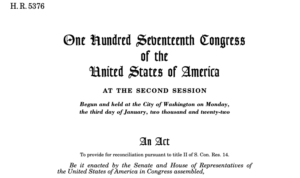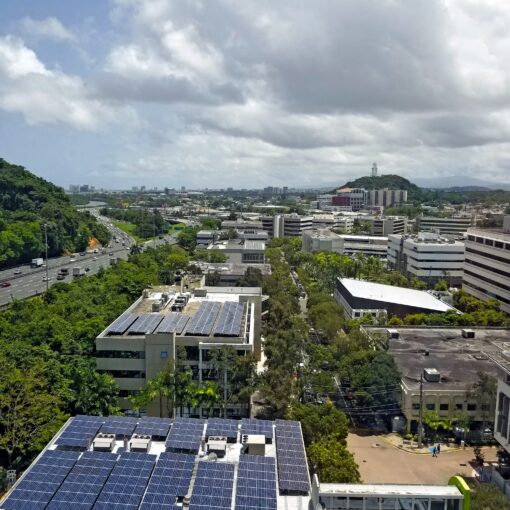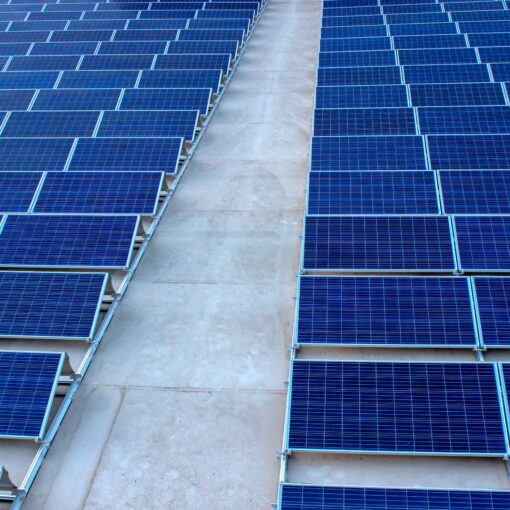On August 16, President Biden signed the Inflation Reduction Act (or “IRA”), widely hailed as the most ambitious piece of climate legislation in U.S. history. The bill is sprawling, covering climate and energy topics as diverse as electric vehicles, building decarbonization, clean energy manufacturing and supply chains, agriculture, and greening the electricity system, all through a range of tax incentives and direct grants. (The bill also has healthcare and prescription drug provisions, makes tax code changes unrelated to climate and energy, and guarantees federal land on- and offshore for oil and gas drilling.) Only portions of the legislation apply directly to units of local government, but taken as a whole it can be expected to help U.S. cities move toward their greenhouse gas reduction goals via a cleaner national electric grid, increased vehicle and building electrification, and new distributed renewable energy resources. Still, how does a local government tap in?
There are six broad ways local governments will need to navigate the IRA.
First, there are several provisions in the legislation through which units of local government may directly draw financial support from a federal agency. Generally, local governments are not the only parties eligible to access funding from a particular program; often states, Indian tribes, and sometimes even private parties are also eligible. In some instances, the IRA specifies a timeframe in which the relevant agency must issue parameters for tapping into funding amounts. Regardless of whether this is made explicit in the IRA, in each case, the relevant agencies will need to make additional details about their respective programs available, whether through formal rulemakings or otherwise. A list of programs for which local governments are eligible appears as an appendix at the end of this blog post.
Second, the IRA includes several direct-to-consumer tax credits and grants for vehicle and building electrification and distributed energy generation, which will help decarbonize those sectors at the local level. Local governments can maximize these programs for their residents through outreach and education about the benefits available. Some of these programs are administered by the federal government, as with vehicle tax credits claimed directly by individual purchasers, while others will be administered by states, as with the rebate programs described in the next paragraph.
Third, some funds will be routed through states and state energy offices. State energy offices, as defined under Section 124(a) of the U.S. Energy Policy & Conservation Act (“EPCA”), are specifically tasked with administering two broad rebate programs for which individuals and building owners are eligible. The first is the HOMES (short for Home Owner Managing Energy Savings) rebate program, to which $4.3 billion is appropriated under Section 50121 of the IRA. Under this program, households and residential building owners are eligible for rebates to cover some of the costs of energy efficiency upgrades. Second, under Section 50122 state energy offices are to administer a $4.275 billion electrification rebate program under which individuals, households, and other eligible entities can receive rebates for electric heat pumps, heat pump water heaters, stoves, and clothes dryers, and for non-appliance home electrical system upgrades. States are also eligible for other funding opportunities and for many of the same funding pools as local governments. While the details of state programs will not be known until applicable state agencies develop them, there is significant room for coordination and advocacy by local governments to state policymakers.
Fourth, local governments with municipal utilities are now eligible to benefit from the IRA’s clean energy tax credits. Section 13801 of the IRA, which adds a new Section 6417 to the tax code, allows states and municipalities, along with other tax-exempt organizations like municipal utilities and rural cooperatives, to receive as a “direct payment” many of the IRA’s tax credits that would otherwise only have value to tax paying entities. The addition of direct pay bolsters the ability of municipally-owned utilities to invest in clean energy generation, as they have no tax liability against which to otherwise claim a credit. Direct pay is available for production, investment, and other tax credits. Municipalities with publicly-owned utilities who are otherwise looking to invest in clean energy generation should discuss applicable parameters with a qualified tax or energy financing attorney.
Fifth, communities that are located near ports can benefit from significant appropriations for port decarbonization. Section 60102 of the IRA adds a new Section 133 to the U.S. Clean Air Act appropriating $2.25 billion for a competitive grant and rebate program for the purpose of “purchas[ing] or install[ing] zero-emissions port equipment or technology” at ports. Funds from this appropriation may also be awarded for planning and permitting relating to such zero-emission equipment and technology, and for a port’s climate action planning. A climate action plan that qualifies for funding under this section must include “a strategy to collaborate with, communicate with, and address potential effects on low-income and disadvantaged communities and other stakeholders that may be affected by implementation of the plan.” An additional appropriation of $750 million is made for the same set of activities in ports located in nonattainment areas, as designated under Section 107 of the Clean Air Act. Local governments with “jurisdiction over a port authority or a port” are eligible to apply for funding. More details regarding funding applications will need to be made available by the EPA, and funding is set to remain available until September 30, 2027.
And sixth, many areas of the IRA have extra set-asides for disadvantaged and low-income communities, as well as “energy communities” (defined as areas that meet certain thresholds for employment or tax revenues from fossil fuel extraction, processing, transport, or storage of coal, oil, or natural gas; that have above-average unemployment rates; that have had coal mine or plant closures since 1999 or 2009, respectively; or brownfield sites as designated under CERCLA). These provisions appear across the IRA and are administered through tax credits, funding programs for which local governments are eligible, and funding programs for which local governments are not directly eligible. Using the range of tools described in this blog post, local governments can help ensure that communities and residents in need of these benefits are in the best position to access them.
The IRA is broadly understood to have the potential to materially transform the U.S. economy and to significantly contribute to its greenhouse gas reduction efforts. Local governments will be central to these efforts, as they’ll be responsible for many of the projects that IRA appropriations ultimately fund. There is much, much more to the IRA than can be summarized in this short blog post; in particular, renewable energy developers will have access to tax credits to help scale up the renewable energy needed to decarbonize at the local level. Materials are emerging about the direct-to-consumer programs and allocations to state governments, which municipalities can use to begin crafting their own approaches to engagement. Local governments will need to watch for federal agencies to make details available with respect to the IRA’s many funding programs.
Local governments have a significant opportunity over the next several years. Cities’ climate action plans contemplate greenhouse gas reductions from buildings, from vehicles, and from energy generation and consumption. The IRA and local climate action planning may be mutually beneficial, with local governments able to access funding for programs included in their climate action plans, and the federal government able to achieve the goals of the IRA through local policymaking and implementation. Moreover, the IRA’s broad decarbonization of the economy through tax incentives, grant programs, and other resources can help reduce local emissions in all sectors. Several provisions – a few of which are directly available to local governments – can additionally help address local air pollution and other inequitable impacts to vulnerable communities. The IRA may be federal legislation but, with local governments’ leadership, it’s poised to remake our communities as well.
APPENDIX: IRA Funding Opportunities for Which Local Governments are Directly Eligible
GHG reductions and climate action planning
- Greenhouse Gas Reduction Fund: a new greenhouse gas reduction fund, administered by the EPA, will provide billions of dollars in direct and indirect investment in projects to reduce greenhouse gas emissions at the local level. Municipalities are eligible for this funding, as are states, Tribal governments, and nonprofit entities that provide and leverage capital to finance projects to reduce greenhouse gas emissions (e.g., “green banks”). First, $7 billion is to be made available for grants, loans, and financial and technical assistance “to enable low-income and disadvantaged communities to deploy or benefit from zero-emission technologies,” including rooftop solar, and other GHG reduction activities. Second, $11.97 billion is made available for grants to provide direct and indirect investment in projects, activities, or technologies that (1) reduce or avoid greenhouse gas and other air pollution by leveraging investment from the private sector or (2) “assist[s] communities in the efforts of those communities to reduce or avoid greenhouse gas” and other air pollution. And third, $8 billion is made available for the same activities specifically in low-income and disadvantaged communities. All amounts are to be made available within 180 days and remain available until September 30, 2024. (Sec. 60103)
- Climate Pollution Reduction Grants: two appropriations to be administered by the EPA are open to municipalities for climate action planning and reduction of greenhouse gas pollution. The first is a $250 million appropriation to support the development of plans to reduce greenhouse gas pollution in support of later projects that implement such pollution reductions. The EPA is to publish a funding opportunity announcement within 270 days, and at least one grant must be made in each state. The second appropriation is for $4.75 billion for grants to implement GHG pollution reductions. Many of the details remain to be determined by the EPA, but applications for funding will need to include “information regarding the degree to which greenhouse gas air pollution is projected to be reduced in total and with respect to low-income and disadvantaged communities.” States, Indian tribes, and air pollution control agencies are also eligible for funding. The funding for planning is set to remain available until September 30, 2031 and the funding for implementation projects is set to remain available until September 30, 2026. (Sec. 60114)
- Assistance for Latest and Zero Building Energy Code Adoption: local governments that have building code authority are eligible as grantees under a Department of Energy Program to assist with developing or adopting these plans. The IRA appropriates $330 million to the DOE to help states and local governments adopt codes that meet or exceed the 2021 International Energy Conservation Code (for residential) or the ANSI/ASHRAE/IES Standard 90.1-2019 (for commercial), as well as for such unit of government “to implement a plan for the jurisdiction to achieve full compliance with any [such] building energy code… which plan shall include active training and enforcement programs and measurement of the rate of compliance.” The IRA additionally appropriates $670 million for the adoption of codes that meet or exceed “the zero energy provisions in the 2021 International Energy Conservation Code or an equivalent stretch code” and for related compliance plans. The funding is set to remain available until September 30, 2029. (Sec. 50131)
- Clean Heavy-Duty Vehicles: a $600 million appropriation to the EPA will fund a program to cover incremental costs associated with replacing non-zero-emissions heavy duty vehicles with zero-emissions heavy duty vehicles, as well as for fueling and charging infrastructure, and for workforce development and technical activities. An additional $400 million is set aside for the same activities in nonattainment areas as designated under the U.S. Clean Air Act. Municipalities and nonprofit school transportation associations, among others, are eligible for these grants. The EPA is directed to develop a program for issuing grants and rebates within 180 days, and the funding is set to remain available until September 30, 2031. (Sec. 60106)
- Low Emissions Electricity Program: A $17 million appropriation is made to the EPA, through an amendment to the U.S. Clean Air Act “for outreach and technical assistance to, and partnerships with, State, Tribal, and local governments with respect to reductions in greenhouse gas emissions that result from domestic electricity generation and use.” The IRA does not specify details for how EPA might allocate funds. The funding is set to remain available until September 30, 2031. (Sec. 60107)
Transportation planning
- Neighborhood Access and Equity Grant Program: a Federal Highway Administration (FHWA) program will provide funding for highway removal, remediation, or capping; mitigating local impacts of highways; building or improving “complete streets, multiuse trails, regional greenways, or active transportation networks”; and providing “affordable access to essential destinations, public spaces, or transportation links and hubs.” $1.893 billion is appropriated for use in any community, and an additional $1.262 billion is set aside for economically disadvantaged communities; communities with community benefits agreements in place; communities with anti-displacement policies, community land trusts, or community advisory boards; and communities with a “demonstrated… plan for employing local residents in the area impacted by the activity or project” covered by this grant program. An additional $50 million is appropriated for technical assistance, including in the form of subgrants to local governments. A cost sharing provision caps the federal grant at 80 percent of the cost of a project, unless the project is located in a disadvantaged or underserved community, in which case the federal contribution may be as high as 100 percent. The funding is set to remain available until September 30, 2026. (Sec. 60501)
- Environmental Review Implementation Funds: a $100 million appropriation to the Federal Highway Administration will provide funding to local governments, among other eligible entities, to facilitate and build capacity for environmental review of surface transportation projects that require federal approval. A cost sharing provision caps the federal share at 80 percent of cost of activities qualifying under this section. The funding is set to remain available through September 30, 2026. (Sec. 60505)
Resiliency, adaptation & local air pollution
- Environmental and Climate Justice Block Grants: a new block grant program will make $2.8 billion available for (1) “community-led air and other pollution monitoring, prevention, and remediation, and investments in low- and zero-emission and resilient technologies”; (2) mitigation of urban heat islands, extreme heat, wood heater emissions, and wildfires; (3) reducing indoor air pollution; (4) climate resilience and adaptation; and (5) “facilitating engagement of disadvantaged communities in State and Federal advisory groups, workshops, rulemakings, and other public processes.” In addition to these direct funding amounts, a $200 million appropriation is made for technical assistance in connection with the foregoing. Local governments are among those eligible for grants. The funding is set to remain available until September 30, 2026. (Sec. 60201)
- Investing in Coastal Communities and Climate Resilience: a $2.6 billion NOAA program will “provide funding through direct expenditure, contracts, grants, cooperative agreements, or technical assistance to” a variety of grantees, including local governments, for “the conservation, restoration, and protection of coastal and marine habitats, resources, Pacific salmon and other marine fisheries, to enable coastal communities to prepare for extreme storms and other changing climate conditions, and for projects that support natural resources that sustain coastal and marine resource dependent communities.” The funding is set to remain available through September 30, 2026. (Sec. 40001)
- State and Private Forestry Conservation Programs: a $1.5 billion appropriation to the Department of Agriculture will support tree planting activities by local governments, states, insular areas, Indian Tribes, and nonprofit organizations through the Urban and Community Forestry Assistance Program. The funding is set to remain available through September 30, 2031. (Sec. 23003)
Other funding opportunities
- Grants to Facilitate the Siting of Interstate Electricity Transmission Lines: local governments that have “authority to make a final determination regarding the siting, permitting, or regulatory status of a” high-voltage interstate or offshore electric transmission line are eligible to receive grants from a $760 million appropriation for impact studies, examination of alternative siting corridors, participation in state and federal regulatory proceedings, and “other measures and actions that may improve the chances of, and shorten the time required for, approval” of transmission lines. The DOE may also use this appropriation to make grants for economic development activities for communities affected by transmission projects. The funding is set to remain available through September 30, 2029. (Sec. 50152)
- Alternative Fuel and Low-Emission Aviation Technology Program: the U.S. Department of Transportation is to make available $244.5 million in funding for projects to produce, transport, blend or store sustainable aviation fuels and $46.5 million for other projects “relating to low emission aviation technologies.” Local governments are among the public and private entities eligible to receive this funding. In selecting projects for funding, DOT is to consider, among other matters, an eligible entity’s capacity to increase production and use of sustainable aviation fuels and technologies in the U.S.; projected greenhouse gas emissions from the project and the potential to reduce lifecycle emissions from air travel; and the potential to create new jobs. A cost-sharing provision caps the federal grant at 75 percent of the spend for most projects. The funding is set to remain available through September 30, 2026. (Sec. 40007)
Amy Turner is the Director of the Cities Climate Law Initiative at the Sabin Center for Climate Change Law at Columbia Law School.







